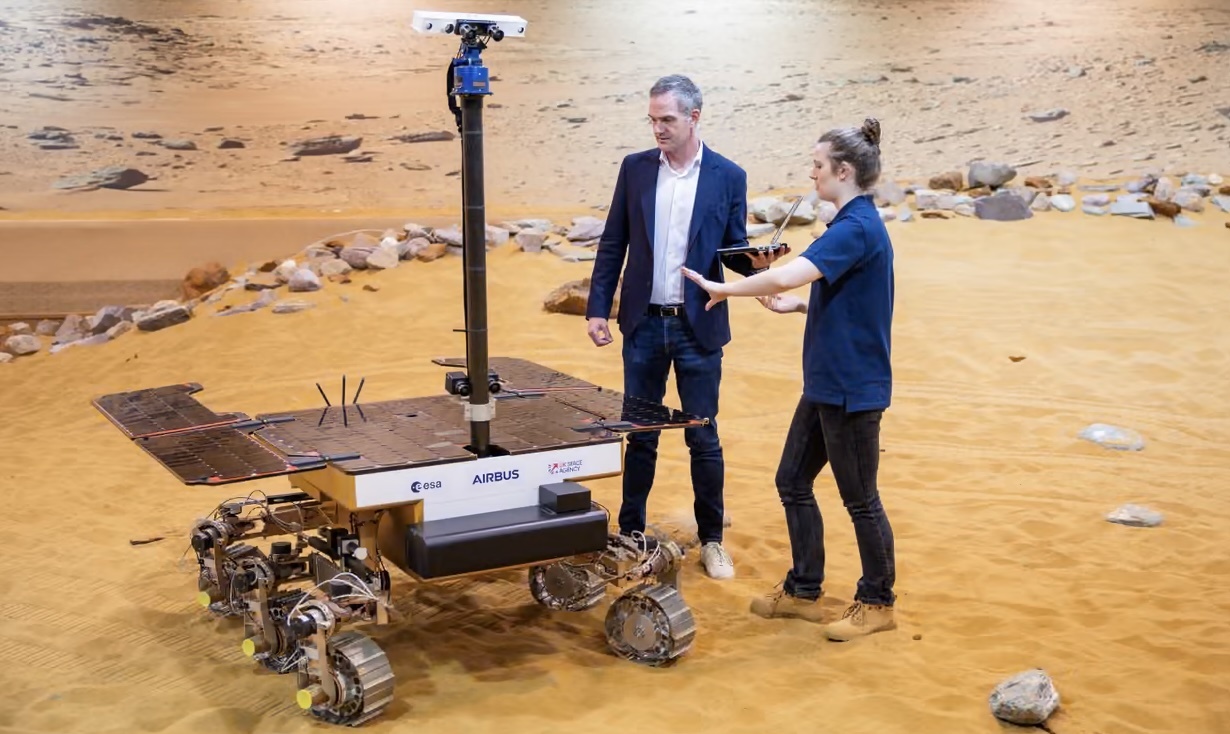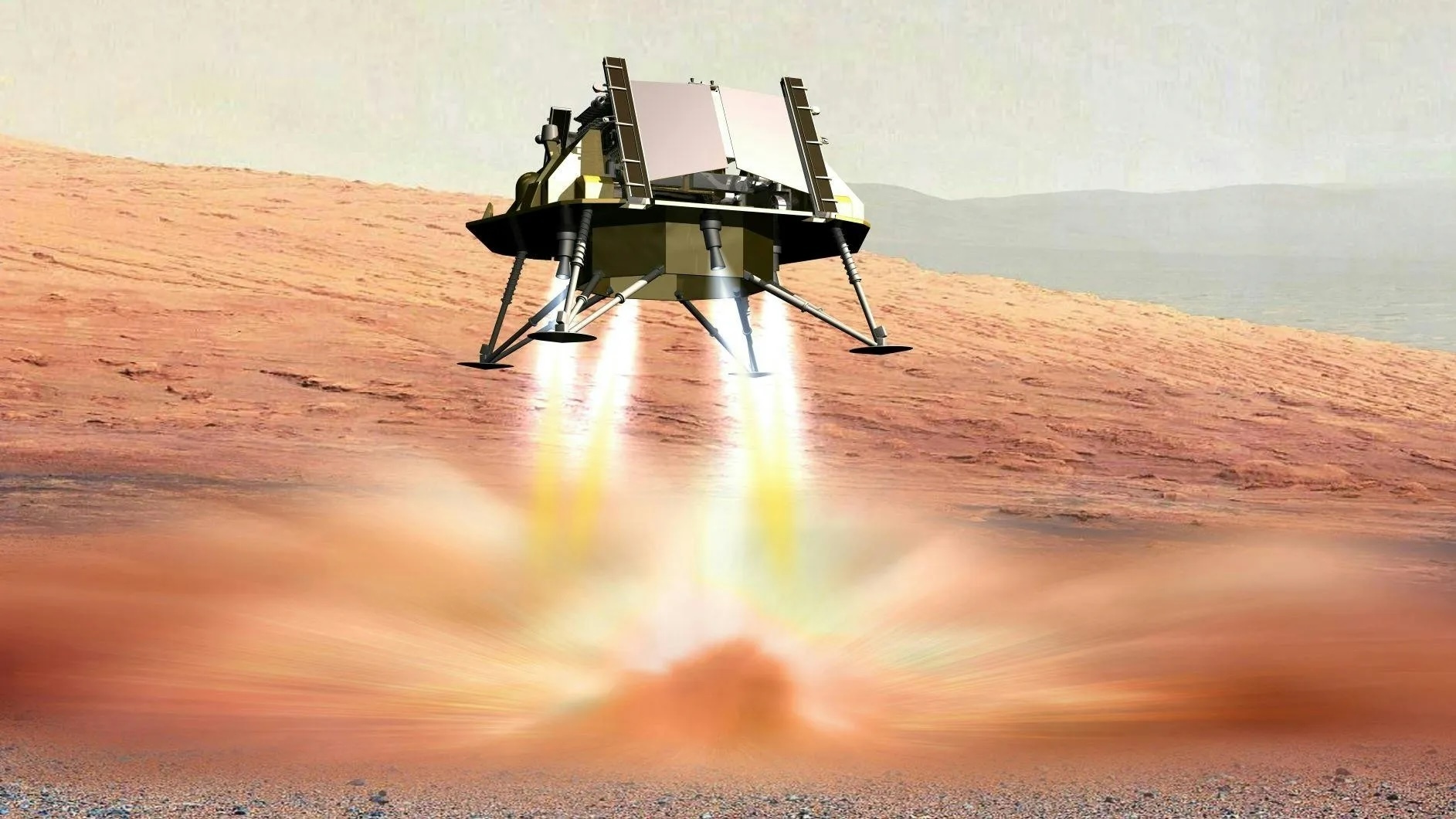30.03.2025
Airbus also built the Rosalind Franklin rover, due to launch in 2028 to search for signs of past life

Peter Kyle, the secretary of state for science, innovation and technology, is shown the Rosalind Franklin rover at the Airbus site in Stevenage. Photograph: Alecsandra Raluca Drăgoi/DSIT
Europe’s first rover to be sent to another planet is back on track to reach Mars, with the lander that will deposit it on the surface lined up to be built in the UK.
The Rosalind Franklin rover – named after the scientist who played a key role in the discovery of the structure of DNA – is part of ExoMars, a European Space Agency (Esa) mission to probe whether life once existed on the red planet, and features a drill to retrieve samples, up to 4bn years old, from two metres below the surface.
Initially a joint project with Roscosmos, the rover was expected to launch in 2022. However, the mission was suspended after the Russian invasion of Ukraine.
But rather than ditch the project, Esa reassessed it, securing more money and striking new agreements for other sources to deliver aspects that were previously to be provided by Russia.
Among them, Nasa will now supply the launcher for the rover, as well as a number of other elements including the rover’s radioisotope heater units (RHUs). Takeoff is expected in 2028 for arrival on Mars in 2030.
Now it has been announced that the rover’s landing platform will be built by Airbus at its site in Stevenage, Hertfordshire, as part of a £150m contract awarded by Esa and funded by the UK government through the UK Space Agency.
The business is no stranger to the mission: Airbus built the Rosalind Franklin rover itself. But, as Caroline Rodier, the project manager of the lander, noted, getting the rover on to the Martian surface is a challenge.
“Landing on Mars is not an easy task, and the schedule is very ambitious as well,” she said.
The idea is that the rover and landing platform will be contained within a capsule Rodier likens to a Kinder Egg, which also features a parachute and a heat shield.
On entering the Martian atmosphere, the first parachute is deployed to slow the capsule to subsonic speeds. Then that parachute, and the capsule itself, is jettisoned before a second parachute – attached to the lander – is engaged.
“And then eventually the platform itself, when it’s getting quite close [to] the soil, will effectively start firing its thruster quite hard in order to land,” said Rodier.
But this landing platform is complex to design: not least as it must be slowed to less than three metres a second before touchdown.
“When you land on Mars with this kind of system, with a platform and thrusters which are firing quite hard in order to break the speed and land safely, it means that you need a propulsion system with a big throughput,” Rodier said.
“If you compare with what we’ve done elsewhere, which are typical spacecraft, other missions, they have a much smaller throughput. So there are challenges, because it is the first time that we are doing this kind of propulsion system.”
Rodier added the team are also working on legs for the lander as well as two symmetrical ramps that will be deployed once it has touched down, allowing the Rosalind Franklin rover to leave the platform via the least risky route.
Rodier added that the rover itself is currently undergoing various tweaks and upgrades now that the launch window has changed, including enhancements to its guidance and navigation control system.
Paul Bate, the CEO of the UK Space Agency, said: “This is humanity defining science, and the best opportunity to find if past life once existed on Mars.
“We’re proud to have funded this world-leading technology. The ripple effects of space exploration discoveries extend far beyond the realm of space exploration, driving progress and prosperity across multiple sectors in the UK, and inspiring technological advances to benefit us all.”
Quelle: The Guardian
+++
Airbus wins contract for ExoMars lander platform

Airbus Defence and Space will build the landing platform that will deliver the ExoMars rover to the surface of Mars. Credit: Airbus
WASHINGTON — Airbus Defence and Space will build the landing platform for the European Space Agency’s ExoMars rover, replacing a critical component originally to be provided by Russia.
Airbus announced late March 28 (Eastern time) that it was selected by ESA and Thales Alenia Space, the prime contractor for the mission, to build the landing platform for that rover mission, scheduled to launch in 2028.
The landing platform is the part of the ExoMars spacecraft that handles the final phases of its descent to the Martian surface in 2030, including performing the final landing burn. After landing, the platform will deploy ramps to allow the ExoMars rover, named Rosalind Franklin, to roll onto the Martian surface.
Airbus did not disclose the value of the contract, but the U.K. government stated it was worth £150 million ($194 million). ESA awarded a contract worth 522 million euros ($565 million) to Thales Alenia Space in April 2024 to restart work on the mission, which was paused in March 2022 weeks after Russia’s invasion of Ukraine. Russia was to provide the landing platform as well as launch the mission on a Proton rocket.
“Getting the Rosalind Franklin rover onto the surface of Mars is a huge international challenge and the culmination of more than 20 years’ work,” Kata Escott, managing director of Airbus Defence and Space U.K., in a statement about the award. Airbus will build the landing platform at its facility in Stevenage, England, where it also assembled the Rosalind Franklin rover.
“We are proud to have built the rover in our state-of-the-art Stevenage clean room and delighted now to develop the project to ensure its safe delivery to Mars,” she said.
ExoMars will also include contributions from NASA. In an agreement finalized in May 2024, NASA will provide throttlable braking engines for the landing platform as well as radioisotope heating units (RHUs), which contain small amounts of plutonium-238 whose decay provides heat to keep the rover warm.
Because of the RHUs, ExoMars will need to launch from the United States, with NASA procuring a launch vehicle at a later date.
Once on Mars, Rosalind Franklin’s instruments will look for evidence of past and present Martian life. The rover includes a drill designed to probe as deep as two meters into the surface.
“This is humanity defining science, and the best opportunity to find if past life once existed on Mars,” Paul Bate, chief executive of the U.K. Space Agency, in a statement about the Airbus contract.
Quelle: SN
